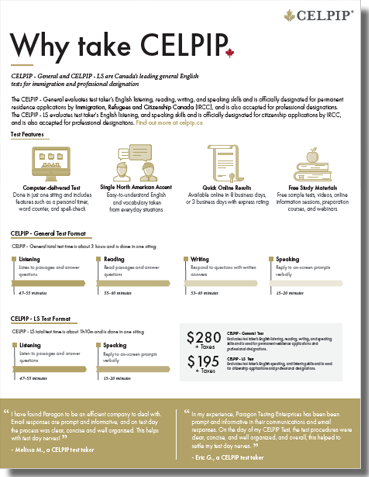
Info Sessions
Attend one of our online CELPIP information sessions to learn more about the CELPIP Tests. Listen from home or on the go. All you need to join us are speakers, an internet connection, and a computer or smart device (Apple or Android).

CELPIP Speaking Pro
CELPIP Speaking Pro features live, interactive lessons that will prepare you to perform at your best! Learn what the CELPIP Speaking Raters listen for when they rate your responses, analyze sample responses from actual test takers, practice responding to each task, and learn valuable tips specific to each Speaking Task. This is a great choice for intermediate-level test takers.

CELPIP Writing Pro
CELPIP Writing Pro gives test takers free interactive lessons that are focused on the Writing component of the CELPIP Test. Writing Pro is available in Target 9+ and Target 5 sessions, so pick which CELPIP level you are aiming for!

CELPIP Reading Pro
CELPIP Reading Pro is a free interactive lesson that is focused on the Reading component of the CELPIP Test. You will learn about the format of each Reading section, strategies for answering the questions, and useful reading skills to practice. This session is for test takers at all language levels.

CELPIP Listening Pro
CELPIP Listening Pro is a free interactive lesson that is focused on the Listening component of the CELPIP Test. You will learn about the format of each Listening section, strategies for answering the questions, and useful listening skills to practice. This session is for test takers at all language levels.

CELPIP Accelerate Starter
When you register for the CELPIP-General or CELPIP-General LS Tests, you will receive Accelerate Starter for free in your CELPIP Account! This online course will help you get the scores you need. Check your CELPIP Account for more information.
For those taking the CELPIP-General Test, you will receive about 5 hours of videos, quizzes, and practice questions. For those taking the CELPIP-General LS Test, you will receive about 2.5 hours of study material.

The Official CELPIP YouTube Channel
Here you will find recorded versions of all of our free webinars, our study tips videos, and our livestream CELPIP Live, which we host twice each month to provide test takers with updates on study products, focus on preparing for components of the CELPIP Test, hearing from test takers, and more!

Watch our Study Tips Videos
Each video features tips and strategies to help you build a study routine that you can follow every day, even if it’s just for a few minutes! All of our study tips have been put together by CELPIP Experts, and include information about other study resources available for free that you can use to prepare!
Free Resources
CELPIP Preparation Program Materials
We offer a variety of free resources to help you prepare and succeed on the test, including guidebooks, online webinars, online practice tests and blog posts offering advice and information.

Download Guidebook
Guidebook for Test Takers
A test taker-focused guide that covers test format, scoring, and more

Download Overview
Overview for Test Takers
A brief overview of the CELPIP test, with information about the test t...

Take the Free CELPIP-General Practice Tests, Starter Set
Free CELPIP-General Practice Tests
Try out 2 full CELPIP-General practice tests for free!

Take the Free CELPIP-General LS Practice Tests, Starter Set
Free CELPIP-General LS Practice Tests
Try out 2 full CELPIP-General LS practice tests for free!
Study Tips from the Experts
Helpful Blog Posts For Preparation
Exclusive offer for newcomers
National Bank of Canada’s exclusive offer for newcomers includes a bank account with no fixed monthly fees for 3 years...
CELPIP Test Now Accepted for Australian Visa Purposes
We are pleased to announce that the CELPIP Test is now designated by the Government of Australia’s Department of Home ...
Strategies and Tips for a High-Stakes Test
High-stakes exams can be intimidating, but they're a part of life for students aiming for college or career success. Hav...

